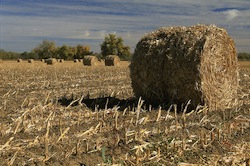Two federal agencies joined the biofuels industry last week in seriously questioning the results of a University of Nebraska study that claims negative greenhouse gas emissions impacts in using corn stover for ethanol production.
 A statement by U.S. Environmental Protection Agency spokeswoman Liz Purchia about the report noted problems with “hypothetical assumption that 100 percent of corn stover in a field is harvested” which she calls “an extremely unlikely scenario that is inconsistent with recommended agricultural practices. As such, it does not provide useful information relevant to the lifecycle GHG emissions from corn stover ethanol. EPA’s lifecycle analysis assumes up to 50 percent corn stover harvest. EPA selected this assumption based on data in the literature and in consultation with agronomy experts at USDA to reflect current agricultural practices.”
A statement by U.S. Environmental Protection Agency spokeswoman Liz Purchia about the report noted problems with “hypothetical assumption that 100 percent of corn stover in a field is harvested” which she calls “an extremely unlikely scenario that is inconsistent with recommended agricultural practices. As such, it does not provide useful information relevant to the lifecycle GHG emissions from corn stover ethanol. EPA’s lifecycle analysis assumes up to 50 percent corn stover harvest. EPA selected this assumption based on data in the literature and in consultation with agronomy experts at USDA to reflect current agricultural practices.”
During a forum on climate change right after the study hit the headlines last week, Agriculture Secretary Tom Vilsack also pointed out that it is based on a false premise. “The study started with an assumption about the way corn stover would be removed from the land. The problem with the assumption is no farmer in the country would actually take that much crop residue,” Vilsack said. “It’s not what’s happening on the ground. If you make the wrong assumption, you’re going to come up with the wrong conclusions.”
Work done by Dr. Douglas Karlen with the USDA Agricultural Research Service was cited several times in the UNL study. In response to questions from POET-DSM, which is using corn stover as feedstock at a plant in Iowa, Karlen said the study “makes unrealistic assumptions and uses citations out of context to reinforce the authors’ viewpoint.”
According to Dr. Karlen, the research fails to differentiate between responsible biomass removal and “excessive” biomass removal, projecting a removal rate of approximately 75% across the entire Corn Belt.
“Harvesting 75% of all corn stover produced in the 10 Corn Belt states is unrealistic, far greater than any projections made by the U.S. Department of Energy (DOE) in their projections for developing a sustainable bioenergy industry, and would certainly result in the depletion of soil organic matter.”

